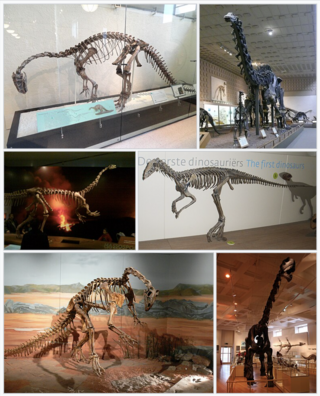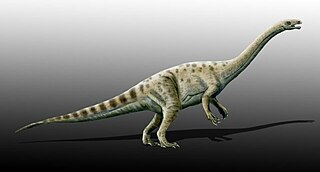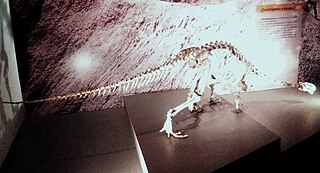
Sauropodomorpha is an extinct clade of long-necked, herbivorous, saurischian dinosaurs that includes the sauropods and their ancestral relatives. Sauropods generally grew to very large sizes, had long necks and tails, were quadrupedal, and became the largest animals to ever walk the Earth. The prosauropods, which preceded the sauropods, were smaller and were often able to walk on two legs. The sauropodomorphs were the dominant terrestrial herbivores throughout much of the Mesozoic Era, from their origins in the Late Triassic until their decline and extinction at the end of the Cretaceous.

Melanorosaurus is a genus of basal sauropodomorph dinosaur that lived during the Late Triassic period. A omnivore from South Africa, it had a large body and sturdy limbs, suggesting it moved about on all fours. Its limb bones were massive and heavy like the limb bones of true sauropods.

Massospondylus was a genus of sauropodomorph dinosaur from the Early Jurassic. It was described by Sir Richard Owen in 1854 from remains discovered in South Africa, and is thus one of the first dinosaurs to have been named. Fossils have since been found at other locations in South Africa, Lesotho, and Zimbabwe. Material from Arizona's Kayenta Formation, India, and Argentina has been assigned to the genus at various times, but the Arizonan and Argentinian material are now assigned to other genera.

Lessemsaurus is an extinct genus of sauropodiform dinosaur belonging to Lessemsauridae.

Antetonitrus is a genus of sauropodiform dinosaur found in the Early Jurassic Elliot Formation of South Africa. The only species is Antetonitrus ingenipes. Sometimes considered a basal sauropod, it is crucial for the understanding of the origin and early evolution of this group. It was a quadrupedal herbivore, like its later relatives, but shows primitive adaptations to use the forelimbs for grasping, instead of purely for weight support.

Blikanasaurus is a genus of sauropodomorph dinosaur from the late Triassic of South Africa. The generic name Blikanasaurus is derived from Greek, meaning "lizard from Blikana". The species name cromptoni is taken from the surname of A.W. "Fuzz" Crompton, an American paleontologist who led numerous field expeditions in Elliot Formation outcrop localities in South Africa. Blikanasaurus is only known from partial hindlimb bones that were recovered from the lower Elliot Formation (LEF) in the Eastern Cape.

Plateosauridae is a family of plateosaurian sauropodomorphs from the Late Triassic of Europe, Greenland, Africa and Asia. Although several dinosaurs have been classified as plateosaurids over the years, the family Plateosauridae is now restricted to Plateosaurus, Yimenosaurus, Euskelosaurus, and Issi. In another study, Yates (2003) sunk Sellosaurus into Plateosaurus. Gresslyosaurus is alternatively considered its own genus or a synonym of Plateosaurus.

Riojasauridae is an extinct family of sauropodomorph dinosaurs from the Late Triassic Period. It contains the genera Riojasaurus and Eucnemesaurus. The Riojasauridae is considered a stem taxon, and is defined as "the most inclusive clade containing Riojasaurus incertus but not Plateosaurus engelhardti, Massospondylus carinatus, or Anchisaurus polyzelus". Geologic formations containing riojasaurid fossils include the Lower Elliot Formation of Orange Free State, South Africa, and the Los Colorados Formation, in La Rioja Province, Argentina.

Massospondylidae is a family of early massopod dinosaurs that existed in Asia, Africa, North America, South America and Antarctica during the Late Triassic to the Early Jurassic periods. Several dinosaurs have been classified as massospondylids over the years. The largest cladistic analysis of early sauropodomorphs, which was presented by Apaldetti and colleagues in November 2011, found Adeopapposaurus, Coloradisaurus, Glacialisaurus, Massospondylus, Leyesaurus and Lufengosaurus to be massospondylids. This result supports many previous analyses that tested fewer taxa. However, this analysis found the two recently described North American massopods, Sarahsaurus and Seitaad, and the South African Ignavusaurus to nest outside Massospondylidae, as opposed to some provisional proposals. Earlier in 2011, Pradhania, a sauropodomorph from India, was tested for the first time in a large cladistic analysis and was found to be a relatively basal massospondylid. Mussaurus and Xixiposaurus may also be included within Massospondylidae.

Anchisauria is an extinct clade of sauropodomorph dinosaurs that lived from the Late Triassic to the Late Cretaceous. The name Anchisauria was first used Haekel and defined by Galton and Upchurch in the second edition of The Dinosauria. It is a node-based taxon containing the most recent common ancestor of Anchisaurus polyzelus and Melanorosaurus readi, and all its descendants. Galton and Upchurch assigned a family of dinosaurs to the Anchisauria: the Melanorosauridae. The more common prosauropods Plateosaurus and Massospondylus were placed in the sister clade Plateosauria.

Glacialisaurus is a genus of sauropodomorph dinosaur. It lived during the Pliensbachian stage of the Early Jurassic period around 186 to 182 million years ago in what is now the central region of the Transantarctic Mountains of Antarctica. It is known from two specimens; the holotype, a partial tarsus (ankle) and metatarsus, and a partial left femur. The fossils were collected by a team led by paleontologist William R. Hammer during a 1990–91 field expedition to the Hanson Formation of Antarctica. They were described in 2007, and made the basis of the new genus and species Glacialisaurus hammeri. The genus name translates as “icy” or "frozen lizard”, and the species name honors Hammer.

Plateosauria is a clade of sauropodomorph dinosaurs which lived during the Late Triassic to the Late Cretaceous. The name Plateosauria was first coined by Gustav Tornier in 1913. The name afterwards fell out of use until the 1980s.

The Elliot Formation is a geological formation and forms part of the Stormberg Group, the uppermost geological group that comprises the greater Karoo Supergroup. Outcrops of the Elliot Formation have been found in the northern Eastern Cape, southern Free State, and in the eastern KwaZulu-Natal provinces of South Africa. Outcrops and exposures are also found in several localities in Lesotho such as Qacha's Neck, Hill Top, Quthing, and near the capital, Maseru. The Elliot Formation is further divided into the lower (LEF) and upper (UEF) Elliot formations to differentiate significant sedimentological differences between these layers. The LEF is dominantly Late Triassic (Norian-Hettangian) in age while the UEF is mainly Early Jurassic (Sinemurian-Pliensbachian) and is tentatively regarded to preserve a continental record of the Triassic-Jurassic boundary in southern Africa. This geological formation is named after the town of Elliot in the Eastern Cape, and its stratotype locality is located on the Barkly Pass, 9 km north of the town.

Adeopapposaurus is a genus of plateosaurian dinosaur from the Early Jurassic Cañón del Colorado Formation of San Juan, Argentina. It was similar to Massospondylus. Four partial skeletons with two partial skulls are known.
Ignavusaurus is a genus of basal sauropodomorph dinosaur that lived during the Early Jurassic in what is now Lesotho. Its fossils were found in the Upper Elliot Formation which is probably Hettangian in age. It was described on the basis of a partial, well preserved articulated skeleton. The type species, I. rachelis, was described in 2010 by Spanish palaeontologist F. Knoll.

Leyesaurus is an extinct genus of massospondylid sauropodomorph dinosaur known from the San Juan Province, northwestern Argentina.
Sefapanosaurus was an early, herbivorous sauropodomorph dinosaur occurring in the southern regions of Gondwana some 200 million years ago in the Late Triassic or Early Jurassic. The sauropodomorphs were the dominant terrestrial herbivores throughout much of the Mesozoic Era, from their origins in the mid-Triassic until their decline and fall at the end of the Cretaceous. A distinctive feature of this dinosaur is the cross-shaped astragalus or talus bone in its ankle. The generic name is derived from the Sesotho word sefapano, meaning ‘cross’ and the Greek word saurus, meaning 'lizard'. The specific name refers to Zastron, the type locality, where the specimen was discovered.

Pulanesaura is an extinct genus of basal sauropodiform known from the Early Jurassic Upper Elliot Formation of the Free State, South Africa. It contains a single species, Pulanesaura eocollum, known from partial remains of at least two subadult to adult individuals.

Lessemsauridae is a clade of early sauropodiform dinosaurs that lived in the Triassic and Jurassic of Argentina, South Africa and possibly Lesotho. A phylogenetic analysis performed by Apaldetti and colleagues in 2018 recovered a new clade of sauropodiforms uniting Lessemsaurus, Antetonitrus, and Ingentia which they named Lessemsauridae. It is a node-based taxon, defined as all descendants of the most recent common ancestor of Lessemsaurus sauropoides and Antetonitrus ingenipes. Depending on the definition of Sauropoda, Lessemsauridae is either one of the most basal sauropod taxa, or a sister taxon of Sauropoda. An additional member of the clade was named later in 2018, Ledumahadi. A 2021 study by Pol and colleagues also assigned the genera Kholumolumo and Meroktenos to the group.




























